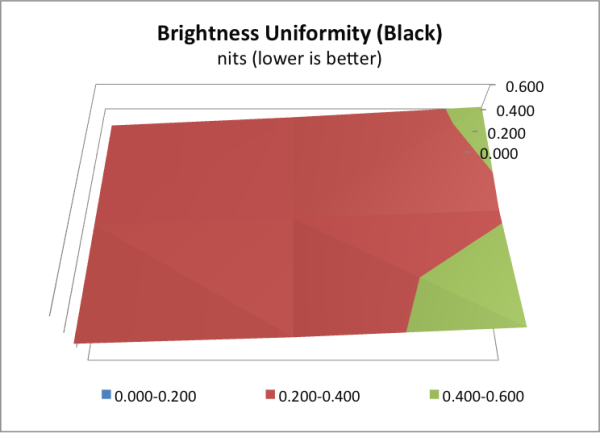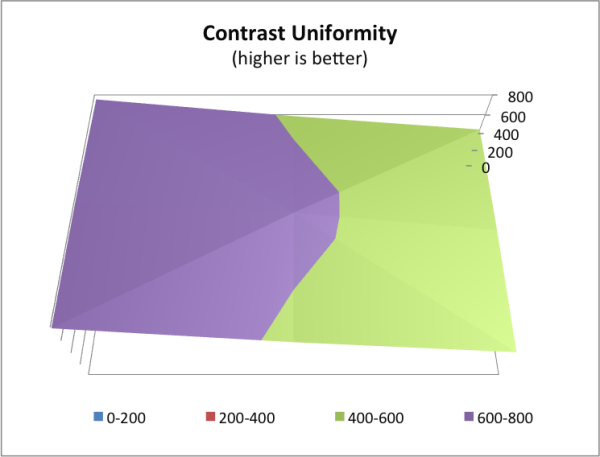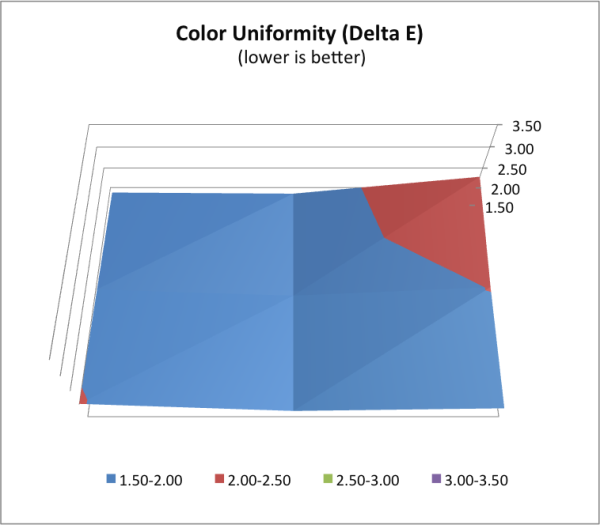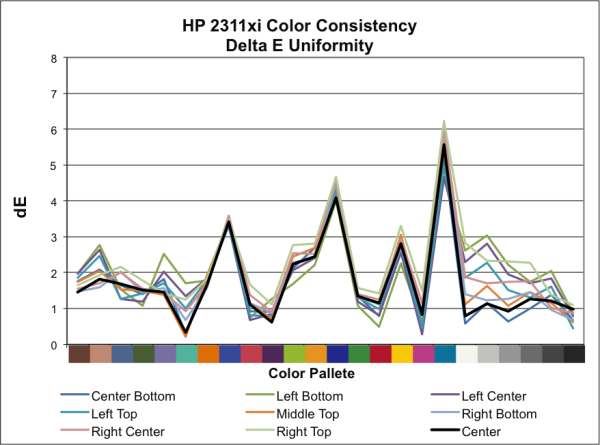HP 2311xi IPS Monitor
by Chris Heinonen on August 13, 2012 12:15 AM ESTHP 2311xi - Display Uniformity
Until now, all measurements on the HP 2311xi have been done in the dead center of the screen where we would expect the best performance. The best displays remain uniform across the whole panel and not just the center, so we measure nine spots across the display to see how well it does overall.
Looking at the white level for 200 nits of light output, most of the screen is very uniform given the price. The right side begins to have some drop off, with light output falling off by 15% at the right center location. This isn’t perfect, but it’s still pretty decent as most of the display is very uniform.
Since the uniformity issues with white are typically caused by uneven backlighting we might expect to see something similar with black levels, and we do. They are uniform across the left and center of the display, but then rise again on the right side of the display. This combination is a bit disappointing as lower white levels and higher black levels mean that we will see a lower contrast ratio when we look at that next.
As mentioned, the contrast is very variable across the screen. It ranges from very good on the left side to pretty poor on the right side. The center is right around what we expect from our previous measurements, but the rest of the screen measures from 780:1 on the left to 409:1 in the lower right.
Looking at the color uniformity, here the upper right corner has the largest issue. Since the backlighting is uneven on the right side, that unevenness can lead to a slightly different shade of light being used in that corner, which can lead to the higher dE we see there. Most of the difference is with the grayscale and not colors, which is common. Overall the color errors are very consistent across the display, even if the level of light isn’t as much on the right side, and it performs better than most displays I see pass through my system as far as uniformity is concerned.
















68 Comments
View All Comments
eallan - Monday, August 13, 2012 - link
So we're comparing full blow laptops with great specs to monitors now?darwinosx - Monday, August 13, 2012 - link
Yeah pretty odd comparison. Also Apple laptop displays have gotten great ratings on this very website.Sabresiberian - Monday, August 13, 2012 - link
So you can't figure out he's just saying that there are high density monitors on the market already, and is just using the Apple Retina display notebooks as an example?piroroadkill - Monday, August 13, 2012 - link
There are very high res TFT-LCDs. Check out the IBM T220/1, 3840×2400, 22.2", back in 2001...Just a very small market for them, or at least there is perceived to be a very small market.
gegiarmo - Monday, August 13, 2012 - link
Why do so many companies refuse to put Displayport in such nice monitors? Does it really cost that much more to add in?jeremyshaw - Monday, August 13, 2012 - link
I'm guessing, but maybe they reused an existing controller PCB to shave costs. Or an older controller ASIC without DP, that was cheaper.Bull Dog - Monday, August 13, 2012 - link
yea honestly I started reading the article and saw, 'with no DisplayPort input' and I felt like not continuing to read any further. No DP input, no chance of my buying it or recommending someone else to get it. DP is the future, get with the times.Bull Dog - Monday, August 13, 2012 - link
but after finishing reading this review it does appear to be a nice monitor for $200.My sister purchased a Dell U2312HM for $240 back when Dell had it on sale. She is quite happy with it and for the little extra $$ you get a much more adjustable stand, Display Port, VESA mounts and matte black plastic.
tk11 - Monday, August 13, 2012 - link
You said it... "DP is the future" but the now is still dominated by DVI / HDMI.Senpuu - Monday, August 13, 2012 - link
A quick wiki search reveals that the first monitor with a DP port was released in January of 2008. Over the intervening years, it's gained rather widespread adoption, to the point that every modern GPU has a DP port. DP provides the most connection bandwidth of any standard, it's adaptable, and it's royalty free to incorporate into your monitor design. It seems a little silly at this point to exclude it from a new product.I'd say that DP is the present...